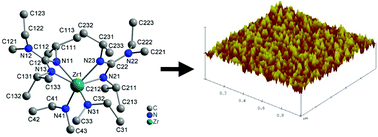A new zirconium complex, bis-(ethylmethylamido)-bis-(N,N′-diisopropyl-2-ethylmethylamidoguanidinato)-zirconium(IV) {[(NiPr)2C(NEtMe)]2Zr(NEtMe)2}, was synthesised by partial replacement of amide ligands with bidentate guanidinate ligands. The monomeric Zr complex was characterised by 1H-NMR, 13C-NMR, EI-MS, elemental analysis, and single crystal X-ray diffraction studies. The thermal properties of the compound was studied by thermogravimetric and differential thermal analysis (TG/DTA). The new Zr compound is thermally stable and can be sublimed quantitatively which renders it promising for thin film growth using vapor deposition techniques like chemical vapor deposition (CVD) and atomic layer deposition (ALD). The use of this complex for CVD of ZrO2 on Si(100) substrates was attempted in combination with oxygen as the oxidant. Stoichiometric ZrO2 films with preferred orientation at lower growth temperatures was obtained and the films were almost carbon free. The preliminary electrical characterisation of ZrO2 films showed encouraging results for possible applications in dielectric oxide structures.

You have access to this article
 Please wait while we load your content...
Something went wrong. Try again?
Please wait while we load your content...
Something went wrong. Try again?


 Please wait while we load your content...
Please wait while we load your content...